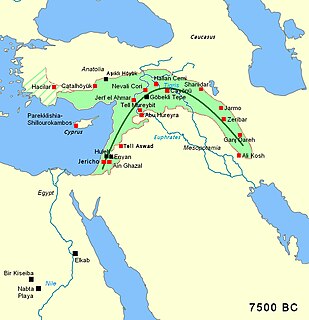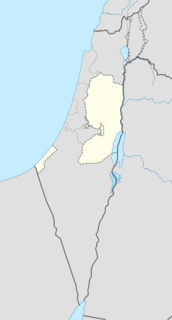 W
WLake Agassiz was a very large glacial lake in central North America. Fed by glacial meltwater at the end of the last glacial period, its area was larger than all of the modern Great Lakes combined though its mean depth was not as great as that of many major lakes today.
 W
WThe Iwajuku site an archaeological site in located in what is now the Kasuke neighborhood of the city of Midori, Gunma Prefecture in the northern Kantō region of Japan with finds from the Japanese Paleolithic period. It received protection as a National Historic Site in 1979.
 W
WThe Neolithic Revolution, or the (First) Agricultural Revolution, was the wide-scale transition of many human cultures during the Neolithic period from a lifestyle of hunting and gathering to one of agriculture and settlement, making an increasingly large population possible. These settled communities permitted humans to observe and experiment with plants to learn how they grew and developed. This new knowledge led to the domestication of plants.
 W
WThe Old Man of the Mountain, also known as the Great Stone Face or the Profile, was a series of five granite cliff ledges on Cannon Mountain in the White Mountains of New Hampshire, United States, that appeared to be the jagged profile of a face when viewed from the north. The rock formation was 1,200 feet (370 m) above Profile Lake, and measured 40 feet (12 m) tall and 25 feet (7.6 m) wide. The site is located in the town of Franconia.
 W
WPre-Pottery Neolithic A (PPNA) denotes the first stage of the Pre-Pottery Neolithic, in early Levantine and Anatolian Neolithic culture, dating to c. 12,000 – c. 10,800 years ago, that is, 10,000–8,800 BCE. Archaeological remains are located in the Levantine and Upper Mesopotamian region of the Fertile Crescent.
 W
WTell Qaramel is a tell, or archaeological mound, located in the north of present-day Syria, 25 km north of Aleppo and about 65 km south of the Taurus mountains, adjacent to the river Quweiq that flows to Aleppo.
 W
WSaharan rock art is a significant area of archaeological study focusing on artwork carved or painted on the natural rocks of the central Sahara desert. The rock art dates from numerous periods starting c. 12,000 years ago, and is significant because it shows the culture of ancient African societies.
 W
WStar Carr is a Mesolithic archaeological site in North Yorkshire, England. It is around five miles (8 km) south of Scarborough. It is generally regarded as the most important and informative Mesolithic site in Great Britain. It is as important to the Mesolithic period as Stonehenge is to the Neolithic period or Scandinavian York is to understanding Viking Age Britain.
 W
WTell es-Sultan also known as Tel Jericho or Ancient Jericho, is the site of ancient and biblical Jericho and today a UNESCO-nominated archaeological site in the West Bank, located two kilometres north of the centre of Jericho. The tell was inhabited from the 10th millennium BCE, and has been called "the oldest town in the world", with many significant archaeological finds; the site is also notable for its role in the history of Levantine archaeology.
 W
WWinnemucca Lake is a dry lake bed in northwest Nevada that features the oldest known petroglyphs in North America. Located astride the border between Washoe and Pershing counties, it was a shallow lake until the 1930s, but was dried when a dam and a road were built that combined to restrict and block water flow. It was formerly designated as a National Wildlife Refuge, but its status as a refuge was removed due to the lack of water.